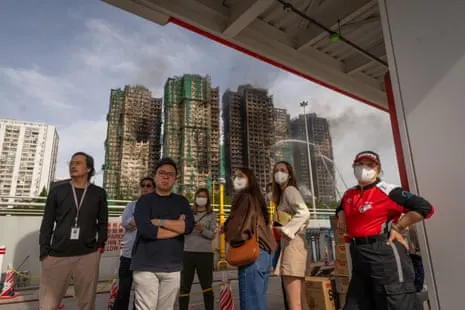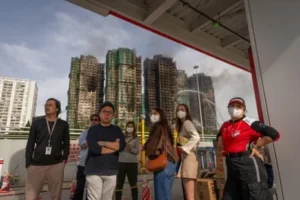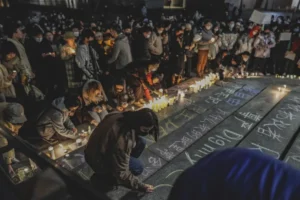While China’s borders remain closed, the global economy suffers
Show caption ‘In order to open its borders, China will first have to vaccinate its population.’ People queue to receive the Covid-19 vaccine in Guangzhou in Guangdong province, China. Photograph: Reuters Opinion While China’s borders remain closed, the global economy suffers Daniel Falush Rigorous testing and 20 million vaccinations a day might see Beijing ready to host the Winter Olympics 2022 @DanielFalush Tue 1 Jun 2021 14.00 BST Share on Facebook
Share on Twitter
Share via Email
In March 2020, I wrote that life was returning to normal in China, but that other countries faced a longer wait. I did not imagine that this longer wait would extend until the summer of 2021. Meanwhile, China has returned to and maintained an essentially pre-Covid state – becoming a kind of parallel universe. In the last year, I have hiked in five provinces, organised a week-long in-person meeting in a tropical botanical garden involving scientists from 20 academic institutions, and attended scores of live music and dance events, featuring maskless musicians playing to packed, maskless crowds. GDP in the first quarter of this year grew 18.3%; in the EU, it fell 0.6%.
China has achieved this success due to the effectiveness of its test, trace and isolate measures. There have been numerous outbreaks of Covid-19 since last spring, varying in size from single cases to hundreds, but all of them have been ended swiftly, with modest, generally localised disruption. The key to this success has been the rapidity and rigour of the measures taken to curtail community transmission.
A good example of epidemiological rigour is provided by the current outbreak in Shenzhen. The index case was a port worker, who as a member of a high-risk group was tested every five days. Once he tested positive, his colleagues, close contacts and neighbours, and their contacts, numbering tens of thousands in all, were tested and quarantined where necessary. The government plans to achieve two negative tests from each person in the entire population of about 240,000 from the local Yantian region, before declaring the crisis over. At the time of writing, eight positive cases have been detected, including other port workers and their family members, none of whom have so much as run a fever.
Finally, the west is doing its own reopening. Will China’s solitude come to an end? China’s Covid suppression has been maintained by nearly closed borders since March 2020. The number of international flights has been kept to a handful a week, and as Chinese epidemiologists have acquired more experience of the improbable ways in which Covid is occasionally transmitted, quarantine has become stricter and longer.
Most people in China would happily stay in this parallel universe for another five years. People feel that they made hard sacrifices in 2020 in order to defeat Covid, and see no reason to be exposed to risks again. However, China’s current border policy is having a cumulative long-term effect across the global economy. Students have postponed their studies, threatening the finances of universities across the globe; small international businesses have shut down; and the belt and road initiative, designed to broaden China’s global impact, has been slowed. Hordes of Chinese tourists are now only found in China. Many have waited for more than a year to reunite with loved ones.
Even if none of these reasons seems urgent, there is something of a hard deadline for substantial reopening to take place in time for the Beijing Winter Olympics in February 2022. The problem is that opening the borders is hard to reconcile with Chinese people’s expectations of zero Covid cases.
In order to open its borders, China will first have to vaccinate its population. The vaccination campaign initially targeted key workers and those with a high chance of being exposed to or transmitting the virus. When the campaign expanded to the general public in March of this year, most preferred to wait and see, especially because the chance of being infected while staying on the mainland is minuscule. At that time, China’s top respiratory expert, Zhong Nanshan, revealed that the number inoculated was 3.56%, a proportion set to rise to 40% by the end of June.
I was vaccinated at the first opportunity, and in the last few weeks the campaign has turned up a notch. Residents from many provinces now get shopping coupons when they are vaccinated, and nationwide 20m doses are being administered every day. I do not think the government will have trouble reaching its targets for vaccination rates. A combination of education, incentives, regular small outbreaks and the occasional rumour about future vaccine shortages is likely to suffice.
The tricky part is that even when the population has been fully vaccinated, there is still the possibility of substantial Covid transmission chains, even if few get very sick. The government will have to convince people that they have to and can live with Covid. Chinese officials are looking with considerable interest at how herd immunity works in highly vaccinated countries with different combinations of vaccines, such as in Israel and Seychelles. Tough decisions will need to be made soon.
• Daniel Falush is a professor at the Center for Microbes, Development and Health at the Institut Pasteur of Shanghai, Chinese Academy of Sciences












